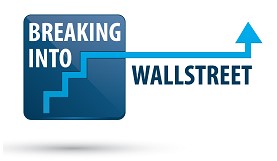 A few weeks ago I was golfing with a salesperson from a sell side research shop and a couple of portfolio managers from other buy side shops. Not exactly bottle service, but certainly enjoyable business entertainment given my passion for golf.
A few weeks ago I was golfing with a salesperson from a sell side research shop and a couple of portfolio managers from other buy side shops. Not exactly bottle service, but certainly enjoyable business entertainment given my passion for golf.
Over the course of normal golf course conversation, one of the other PMs told me his wife was the head of all social media for a large, national retailer.
“Interesting,” I said. “How did she get that job?”
He proceeded to tell me a story about how she started in social media as the “big brother” for this company. In a nutshell, she monitored the internet and social networking sites for any mention of the company’s name. If an employee posted something negative about the company, they were fired.
FIRED.
That got me thinking that we live in a brave new world and you need must be ready before social media ruins your career or your chance at a job on Wall Street. Of course, the power of social media just might be the networking key to breaking into the world of finance. As with all tools, it depends on how you use it.
In this article I will attempt to make sense of the new social networking landscape and show you how it can become a tool in your career search arsenal.
Some Cautionary Tales
To better understand the implications of your social media usage, it is important to look at some extreme examples of social media gone wrong to fully understand the consequences of your online actions.
While there are cautionary tales abound, a couple of examples should suffice. The first example involves the Congressman with the unfortunate, yet terribly amusing last name and the other involves an internet meme near and dear to every Wall Street-er’s heart.
The Rep. Named Weiner
Anthony Weiner was a 46-year-old, up-and-coming US Congressman from New York when he accidentally posted a link to a suggestive photo of himself to a 21-year-old woman following him on Twitter. It wasn’t exactly NSFW, but it wasn’t something you’d want on your computer screen if the boss walked in.
Accidents happen, and realizing his mistake, Rep. Weiner immediately deleted the link. Unfortunately, the damage was done. Soon a flood of [ahem] inappropriate Anthony Weiner photos started surfacing everywhere.
As it turned out, Rep. Weiner had a photo-taking proclivity that would make Brett Favre blush. Rep. Weiner admitted to sending these photos to six women over the course of three years.
This would probably not be a big deal for most people, certainly not career ending. However, it is a big deal when you are a married US Congressman. Did I mention Bill Clinton officiated Rep. Weiner’s marriage ceremony? There’s probably a tremendous amount of irony in that sentence, but we’ll move on …
Less than three weeks after the first photo appeared, Rep. Weiner resigned from Congress. A career ended as a result of a few inappropriate photos.
Are there any inappropriate photos of you on the internet? If your goal is to become a BSD (oh yeah, pun intended, this is too easy), you might want to take a few lessons from Rep. Weiner and re-assess your online photos.
Impossible is Nothing
Anyone who was anywhere near Wall Street in 2006 remembers this resume. If you’ve used the right resume templates and think you have the best resume on the Street, I’m here to tell you that you have nothing on Aleksey Vayner.
Aleksey Vayner has the most famous resume ever. His resume even earned mentions in The New York Times and The New Yorker.
Unfortunately, this resume became famous for all the wrong reasons. In a video accompaniment to his paper resume, we see Mr. Vayner performing outrageous feats such as bench pressing 495 lbs., demonstrating a supposed 140 mph tennis serve, and a martial arts scene where he breaks seven bricks with the palm of his hand.
It wasn’t your typical investment banking resume. It was pretty outrageous, and one UBS employee felt compelled to send this video to his friends.
The video made its way around the world of finance like wildfire. It because an instant internet meme.
While the video was an internet sensation, it was the nail in the coffin of young Aleksey’s potential Wall Street career. Especially when the internet’s collection of I-team investigators exposed several of Mr. Vayner’s boasts were false. He became untouchable by any employer.
Two seemingly innocuous online activities, two careers ended in the blink of an eye. But, that’s the world today and the speed of information is only getting faster. If you need some simple advice, I’ll remind you of a quote from Dr. Denis Leary, “Life sucks, get a fucking helmet.”
The Good News
Of course, social networking can’t be all that bad. After all, we’re talking about billion-dollar companies.
Now that you’ve learned the catastrophic consequences of social media usage gone awry, it’s time to focus on the benefits of social media and how you can use it.
We live in a new information age that has destroyed nearly all boundaries around the globe. On one hand that means your video resume can make it around faster than Earth rotates around the sun, but it also means there is a tremendous opportunity to find any job anywhere.
Take me, for instance. In addition to managing money by day, I am also the Founder of Life on the Buy Side and an Associate Editor at Mergers & Inquisitions. Brian DeChesare (the Founder of Mergers & Inquisitions) and I have never met in person. We’ve spoken on the phone and traded many emails, but we’ve never met in person. Yet he “hired” me to write for his site.
Think about that for just a minute. Only in today’s information and socially connected world is that possible. A generation ago our paths would probably have never crossed.
The same opportunity is available to you, if you know how to use it and what to avoid.
What NOT to Do
Don’t Post Anything You Wouldn’t Show Your Parents or Your Future Children: Imagine showing your Facebook photos to your parents today or your future children 10 (OK, maybe 15, um, er, 20) years from now. Either scenario is possible.
You might think your photos are safe behind some sort of non-public barrier, but nothing is truly safe once it is out there on the internet. And once it is out there, it is out there forever. The internet is growing, not shrinking. Remember that … now is the time to invest in data centers if real estate is your gig.
I’m not saying that you need to completely sanitize your online activities. Just use a little common sense when posting photos, comments, Tweets, or anything else online. A photo of you and your friends having a good time at a club? Not a problem. A photo of you naked on the Wall Street bull? Probably a bad idea if your goal is to work on Wall Street.
Do Not Assume Employers Won’t See Your Social Media Activity: Remember the “big brother” at the large retailer? Assume every company has one. The last thing you want is to land a job offer and have it pulled out from under you because they discovered you are possibly a serial killer.
Always remember that the business of Wall Street involves other people’s money. Despite the perceptions that it is an anachronistic, Darwinian free-for-all, Wall Street activity is still based on trust. Would you want to do business with someone you didn’t trust?
I didn’t think so.
Don’t think your online activities or your private life can be discovered? Think again. If you don’t understand how easy it is to check into an employer or job candidate, please check out this brief tutorial.
How to Use Social Media for Career Success
Utilize LinkedIn to its Full Potential: I will readily admit that I have yet to use LinkedIn to its full potential, but that’s because the potential is so vast.
LinkedIn is a really just the modern-day version of a Rolodex. Only it’s a Rolodex on steroids.
First, our forefathers had the Rolodex. A neat little wheel of index cards with contact information for people in your network. You would handwrite the contact information or tape a business card to an index card.
Then we digitized the Rolodex in the form of Microsoft Outlook or some other contact organizational tool in the PC-era. It was a vast improvement as changes became easier to implement and contacts became searchable.
Then came LinkedIn. There is a reason LinkedIn was the most successful IPO of 2011. Investors recognized its potential (plus it even had positive revenues and cash flow, unlike pets.com).
LinkedIn is a Rolodex meets Outlook meets Skynet. It’s a Rolodex that has become self-aware.
The problem with traditional contact management systems is that they quickly become out of date. People change jobs, changes offices, change email addresses… whatever contact information you can think of, people will change. This means you need to update your contact database all the time in order for it to remain relevant.
Not so with LinkedIn. Since every connection maintains their own LinkedIn page, the likelihood of your contact database remaining up-to-date rises dramatically. So if your old classmate from undergraduate school, who you haven’t seen in a few years, lands a new job and updates her LinkedIn page, you get an update in LinkedIn. That’s a perfect time to follow-up and stay connect by send a “Congratulations” message.
The ability to stay connected and make new connections has risen exponentially with the creation of LinkedIn.
Use Social Media as Your Own Personal Brand Enhancer: Use the fact that “big brother” is searching for you on the internet to your advantage. Keep your online profiles up-to-date with relevant information. This includes turning your LinkedIn page into your resume.
When people search for you, make sure they discover all the good things about you and none of the negative things. Manage you own personal brand the same way the large retailer managed its brand: fire the bad information and promote the good information.
Solidify Chance or One-Time Encounters: Imagine you meet and party with some investment bankers or a couple of analysts at a hedge fund some random weekend during the summer. You have a great time and they give you their business cards and say to give them a call once recruiting begins in the fall.
What are the odds they will remember you two months from now? Not very good. But, if you can get a business card and immediately follow-up with a LinkedIn connection, then you’ve cemented the chance encounter for good.
Now, in two months when you are looking for a job and realize you failed to follow-up and stay in touch with your contact, a cold call is instantly made warm by the fact that you have a LinkedIn connection.
Use, but Use Wisely
Social media and the internet can be a boon to your career or it can end it prematurely. The good thing is that you control your own destiny. Be smart and use it to your advantage.
If you remember just one thing about managing your reputation and brand online, remember this quote from Warren Buffett:
“It takes 20 years to build a reputation, but only five minutes to ruin it. If you think about that, you’ll do things a lot differently.”
Remember those words, work hard, and you just might enjoy a prosperous career on Wall Street.


